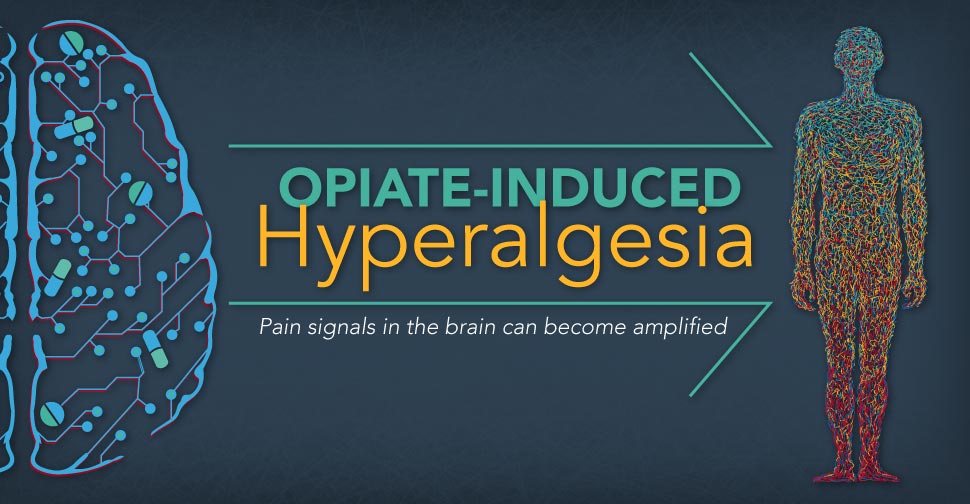
Opiate prescription treatments are on a steady incline in the United States for chronic and short-term pain management. This rise has caused many people to experience multiple adverse effects when taken long-term. One notable side effect of long-term opiate consumption is a condition known as opiate-induced hyperalgesia, or OIH. Opiate-Induced Hyperalgesia occurs when opioids cause acute sensitivity to stimuli or aggravate preexisting pain. There are many theories surrounding the cause of OIH. Thankfully, there are methods to control this painful condition.
What Is Hyperalgesia?
Hyperalgesia is a condition which causes the sufferer to have an abnormally high sensitivity to pain. This is believed to be caused by damaged pain receptors, or peripheral nerves in the brain. It is believed that pain signals in the brain can become amplified or pain relieving signals can become slower in those experiencing hyperalgesia. Those suffering from hyperalgesia will experience:
- Pain without injury or any notable reason
- Significantly more profound pain than the stimuli suggests
- Decrease in pain tolerance
- Decrease in pain threshold; the point when pain is first experienced
- Pain spreading from one place on the body to another
It is important to remember that hyperalgesia is not determined by the actual pain dealt, but how it is perceived by the person experiencing the stimuli. One may experience temporary hyperalgesia during acute sickness, such as flu or while fighting other infections in the body. This could be due to inflammation, overheating, dehydration, or other factors involved when fighting illness.
How Do Opiates Cause Hyperalgesia?
While it is unclear exactly how an analgesic causes such an opposite effect in some people, it is understood that opiates can be damaging to receptors in the brain over time. It is also believed that pain threshold and tolerance can be lowered due to extended use of opiates. Lower doses of opioids can cause hyperalgesia, however, it is far more common in higher doses.
OIH Diagnosis And Treatment
Opiate-induced hyperalgesia is often hard to diagnose, as tolerance and OIH are similar in nature. When pain is not improved or is made worse with increased doses, physicians often suspect OIH as the cause. Patients may also experience pain in other parts of the body, which raises additional red flags during diagnosis. While opiates can induce hyperalgesia directly when taken, there are similar forms of the condition that are categorized differently due to the diagnosis and treatment processes.
These conditions are related to, but not directly categorized as opiate-induced:
- Allodynia is when the patient reacts to a benign stimulus with excruciating pain. It is diagnosed with a sensory exam and can be treated with less or more opioids.
- Opioid tolerance can cause hyperalgesia, is clinically diagnosed, and may be treated with more opioids.
- Withdrawal-induced hyperalgesia is experienced during the withdrawal period, and is tested with a scaling system and clinical diagnosis. A tapering of opioids, often with antagonist opiates, is used to treat the pain.
These forms of hyperalgesia are often confused with OIH, but have different categorization. This is why physician intervention is important for treatment. Some may mistake OIH for increased tolerance and raise the dosage to alleviate pain. This can make matters worse if OIH is the cause, when less opiates are actually necessary. In contrast to conditions listed above, opiate-induced hyperalgesia is diagnosed with a trial decrease in opiates to treat pain. If decreasing a dose does not relieve pain, patients may try an NDMA antagonist or buprenorphine.
An Unexpected Occurrence
With proper dosing and duration, opioids can be a positive method of chronic pain management. While undergoing treatment for pain, the last expected side effect is more pain. Unfortunately, opiate-induced hyperalgesia is a common occurrence in many people undergoing long-term opioid treatments. When opioids cause more pain, it is important to reach out to the administering physician to adjust the dosage and rule out other factors that may be causing trouble. Identifying the symptoms and seeking medical intervention is the very best course of action to find relief.
We Can Help
 If you or a loved one is experiencing opiate-induced hyperalgesia, you are not alone. The caring staff at DrugRehab.org is here to help guide you through. We can answer any questions you may have about opioid treatments, hyperalgesia, addiction, and treatment. We’re here for you. Contact us today.
If you or a loved one is experiencing opiate-induced hyperalgesia, you are not alone. The caring staff at DrugRehab.org is here to help guide you through. We can answer any questions you may have about opioid treatments, hyperalgesia, addiction, and treatment. We’re here for you. Contact us today.

